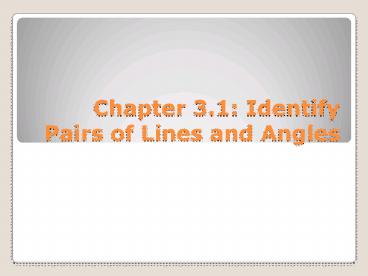Chapter 3.1: Identify Pairs of Lines and Angles - PowerPoint PPT Presentation
1 / 19
Title:
Chapter 3.1: Identify Pairs of Lines and Angles
Description:
Chapter 3.1: Identify Pairs of Lines and Angles M11.B.2.1, M11.C.1.2 What angle pairs are formed by transversals? Parallel lines never intersect are coplanar The ... – PowerPoint PPT presentation
Number of Views:226
Avg rating:3.0/5.0
Title: Chapter 3.1: Identify Pairs of Lines and Angles
1
Chapter 3.1 Identify Pairs of Lines and Angles
2
M11.B.2.1, M11.C.1.2
- What angle pairs are formed by transversals?
3
- Parallel lines
- never intersect
- are coplanar
- The symbol for parallel lines is
- If line l is parallel to line m you can represent
it with l m . - When 2 drawn lines are parallel there will be
little arrows or triangles on the lines.
4
Are these parallel judging by sight?
R
5
Are these parallel?
S
6
Are these parallel?
7
Are these parallel?
y
z
8
Parallel Planes
- Parallel planes are two planes that do not
intersect.
9
Perpendicular Planes
- Perpendicular Planes are planes that intersect at
a 90 angle.
10
Skewed Lines
- Skewed lines do not intersect, but are not
coplanar. - The last 2 examples were examples of skewed lines.
11
(No Transcript)
12
Parallel Postulate
- If there is a line and a point not on that line,
then you can draw only 1 line parallel to the
line that passes through that point.
.
13
Perpendicular Postulate
- If there is a line and a point, then there is one
line that passes through the point that is
perpendicular to the line.
.
14
(No Transcript)
15
- Page 150
- 3-10
16
Transversals
- Transversals are lines that intersect two or more
coplanar lines at different points. - In other words a line that intersects 2 other
lines.
?transversal
17
There are 4 different angle relationships created
by a transversal
- Corresponding angles same side of transversal
and of the individual lines. (angles 2 and 6) - Alternate interior angles on the inside of the 2
lines, but on either side of the transversal.
(angles 4 and 5)
18
- Alternate exterior angles on the outside of the
lines, but on opposite sides of the transversal.
(angles 1 and 8) - Consecutive interior angles on the inside of the
lines and on the same side of the transversal.
(angles 3 and 5)
19
Identify Angles































